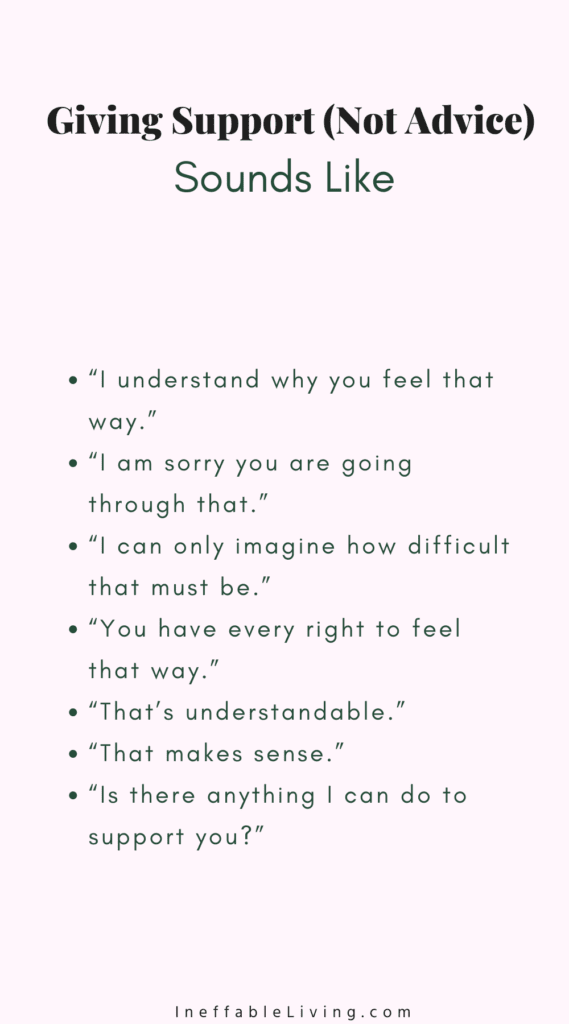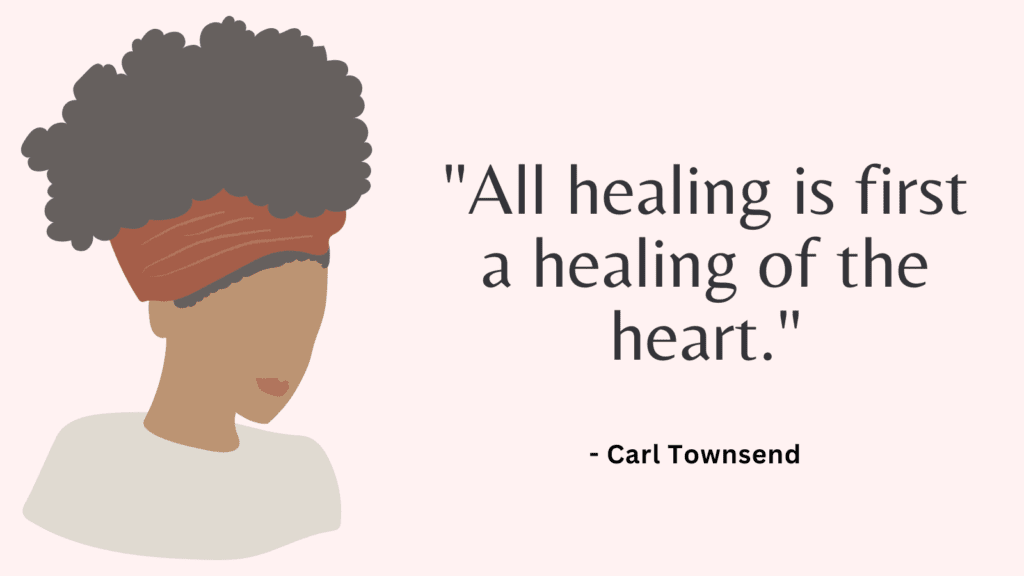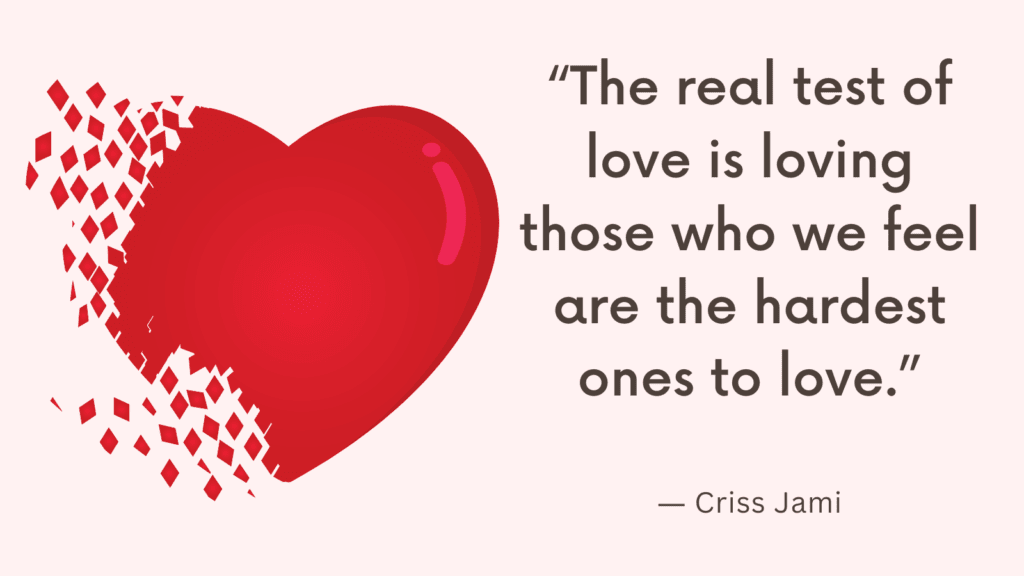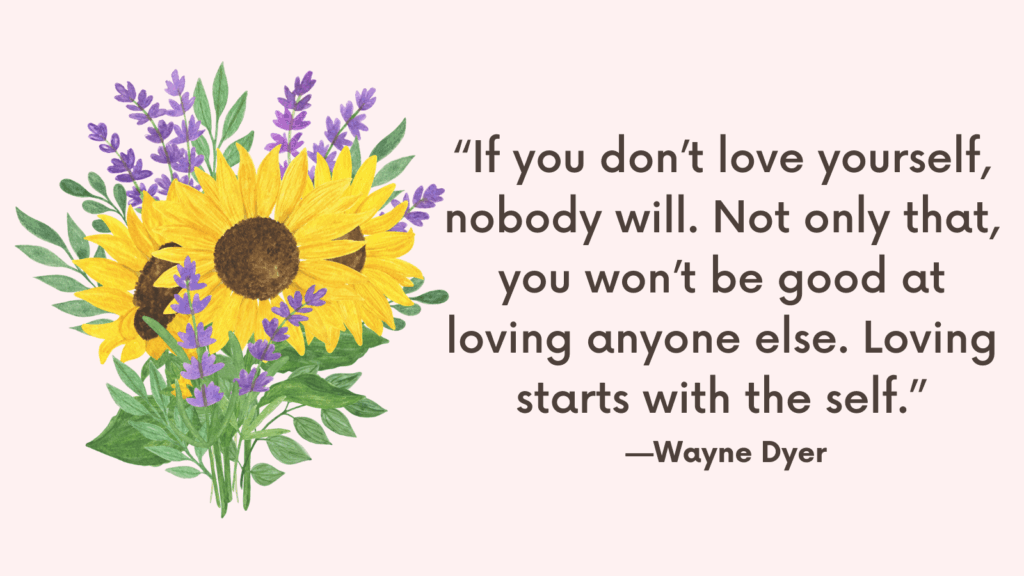Today, you’ll discover how to validate someone’s feelings without agreeing with them and listen without giving advice.
“In modern life, we are encouraged to listen to our hearts, listen to our inner voices, and listen to our guts, but rarely are we encouraged to listen carefully and with intent to other people.” – Kate Murphy
Validation is the act of helping someone feel heard and understood.
It has the power to boost the other person’s positive emotions and reduce the painful ones. (*)
It also makes the other person much more open to your advice. (*)
- What Does It Mean To Validate Someone’s Feelings?
- How To Validate Someone’s Feelings Without Agreeing?
- Forms of Validation
- What Validating Is Not?
- Can You Share Your Opinion or Give Advice?
- Examples of Validating Statements
- Examples of Invalidating Statements
- FREE Validating Statements Worksheet
- How To Become A Better Listener?
- Self-Validation
- Got it? Try it.
What Does It Mean To Validate Someone’s Feelings?
Validating someone’s feelings means acknowledging and accepting their emotions as real and understandable, regardless of whether you agree with them or not.
This can involve listening to their concerns without trying to change their mind, offering support and empathy, and recognizing that their feelings are valid and important to them.
By validating someone’s feelings, you show them that you care about their well-being and are willing to listen and understand their perspective.
How To Validate Someone’s Feelings Without Agreeing?
Forms of Validation
Validation comes in three forms; emotional, behavioral, and cognitive.
1. Emotional validation
Emotional validation involves validating without escalating the emotion. The way to do that is by focusing on the primary emotions the other person is experiencing.
Emotions, such as anger and anxiety, are secondary emotions because they’re easier to recognize. Primary emotions, such as sadness or hurt, are more difficult to recognize.
So when validating, try to identify those underlying emotions. This will help de-escalate their emotional response.
Validating anger is helpful, but validating the underlying hurt can shift the other person’s emotions and allow them to pay attention to the nuances of all of the different emotions that they’re experiencing.
The emotional validation you give by listening and identifying emotions, also allows the other person to express themselves more openly. That can be validating in and of itself. (*)
Related: How to Become More Empathetic? The 6 Habits of Highly Empathetic People
How to identify emotions?
Imagine being in a similar circumstance.
Ask yourself, “Have I been in a situation similar to this in some way?” If it’s not, “can I imagine being in that same position?”
Based on what you know about the person, ask yourself, “How do they likely think and feel?”
We can usually put ourselves in the other person’s position and imagine what thoughts are going through their head or what feelings they have. Then we can articulate those and check that we’re understanding things correctly.
We can directly say things like “that makes sense,” or, “I can see that.” And that would be an example of emotional validation.
Self-Disclosure
Self-disclosure isn’t about telling the other person a story about how things have happened to you.
While there is nothing wrong with that per se, when it comes to emotional validation, self-disclosure involves things like laughing when a person tells a funny story or crying when a person tells an emotionally heart-wrenching story.
Emotional expressions are actually self-disclosures and that’s another example of emotional validation.
Related: 12 Actionable Tips to Fix Lack of Empathy and Become a Strong Empath
2. Behavioral Validation
Behavioral validation involves validating the other person’s behaviors by communicating that they’re understandable regardless of whether these behaviors are helpful or not.
For example, “It makes sense that you would cut yourself after what happened, the emotional pain was so unbearable, you really a relief, and it’s worked before.”
Simply repeating back what the facts of the situation are, such as saying, “So you used an emergency razor that you kept in the glove box,” without trying to make something of it, is also a form of behavioral validation.
3. Cognitive Validation
Cognitive validation is when you recognize and identify the underlying assumptions and beliefs of the other person and then articulate them and find the validity.
In a way this involves mind-reading. Based on what you know about the other person, or even based on what you know about human beings in general, look at any patterns they might have.
For example, if you know that the other person struggles with feelings of shame, you might verify with him by asking, “Did you feel like you didn’t deserve being with that person?”
You May Be Interested In
Supporting Someone With An Eating Disorder (What to Avoid and What to Do Instead)
Supporting a Grieving Person The Right Way (What to Say and What not to Say)
Supporting Someone With OCD: 7 Ways You Can Help Someone With OCD

What Validating Is Not?
1. Validating Doesn’t Mean Reinforcing
There is a fine line between reinforcing and validating.
The purpose of validation isn’t maintaining an unhealthy behavior or escalating a negative emotion.
Validation is about communicating understanding and helping the person feel more accepting and open to change.
The best way to know whether you’re validating or reinforcing is by observing how validation is being received and what’s happening with their behavior. Is it increasing, decreasing, staying the same over time?
Related: Supporting Someone With An Eating Disorder (What to Avoid and What to Do Instead)
2. Validating Doesn’t Mean Agreeing
Most people’s reactions make perfect sense, once you put yourself in their place and understand where the other person is coming from (their past experiences, their fears, the fact that they might have all the details, etc.)
Still, you might find yourself thinking that they’re being irrational.
If you find it hard to validate someone, try asking for further information-seeking questions to help you understand their reaction better.
“What about that do you think is unfair?”
“Did she tell you that, or was it something you came to understand from her behavior?”
If they’re, for instance, misreading the situation, that can help you understand their reaction and validate their feelings, given their perspective and experience.
Related: Supporting a Grieving Person The Right Way (What to Say and What not to Say)
Can You Share Your Opinion or Give Advice?
Absolutely.
Validation sets you up for a more effective conversation.
But before you can share your opinion or give advice, the other person needs to feel heard and understood before they can be receptive to any input.
ProTip: Asking permission to share your opinion or give advice can show tremendous respect for the other person and make them much more receptive.
Related: 4 Keys To Communicate Effectively With Anyone
Examples of Validating Statements
There are different ways you can communicate validation. As long as you show the other person that you recognize and understand their emotions, you’re validating:
- “Here’s what I’m hearing you say (fact checking).”
- “I can see how hard you are working.”
- “I can see that you are very (upset, sad, frightened, scared, etc.).”
- “I can see this is important to you.”
- “I can see you are making an effort.”
- “I would have felt the same way. I would be (upset, frustrated, scared) too!” (Self-disclosure)
- “It makes sense you would be so upset about that. “
- “No wonder you’re feeling confused.”
- “Tell me more.” (shows interest)
- “That is so sad.”
- “That must have been hard for you.”
- “That’s got to be so (frustrating, difficult, upsetting, etc.) for you.”
- “What a frustrating experience to go through!”
- “You have every right to feel sad; that was a major disappointment!”
Examples of Invalidating Statements
An invalidating response is anything that minimizes or dismisses the other person’s feelings.
Invalidation disrupts relationships and creates emotional distance.
The following are some examples of invalidating responses to avoid:
- “At least it’s not…”
- “Don’t be such a baby/wimp.”
- “Here we go again, cry over nothing.”
- “I bet she was just…” (Rationalizing the other person’s behavior)
- “I hated it when that happened to me.” (Making it about you)
- “I’m going to talk to him and…” (Trying to fix their problem)
- “If you had only…”
- “It could be worse!”
- “Just ignore him.”
- “Just try to see the good side and tough it out.”
- “Oh, you think you have it bad…”
- “Well, life’s not fair…”
- “What you really should do is…” (Unsolicited advice)
- “What’s the big deal?”
- “Why can’t you be like your sister?”
- “You always get yourself into these situations.”
- “You should feel grateful…”
- “You shouldn’t think that way.”
- “You’ll be fine.”
- “You’re so dramatic.”
- “You’re too sensitive.”
More often than not, these responses leave the person feeling worse. They’re suggesting that the person is being irrational or “too sensitive.”
Invalidation also includes nonverbal invalidation, such as rolling of the eyes, drumming of fingers in an impatient way, constantly checking your watch or your phone, etc.
This will probably prevent the other person from opening up or being receptive to any advice.
FREE Validating Statements Worksheet
How To Become A Better Listener?
Becoming a better listener takes practice and effort, but it is a valuable skill that can improve communication and relationships.
Here are some tips for becoming a better listener:
1. Avoid distractions: Turn off your phone or put it on silent to avoid distractions. Make eye contact and face the speaker.
2. Don’t interrupt: Let the speaker finish speaking before responding. Interrupting can be rude and disrupt the speaker’s train of thought.
3. Show interest: Show the speaker that you are interested in what they have to say. Ask questions and nod your head.
4. Repeat: Repeat or rephrase what the speaker said to clarify your understanding. This also shows the speaker that you were listening and gives them a chance to correct any misunderstandings.
5. Don’t rush: Take your time and allow the speaker to speak at their own pace. Rushing can make the speaker feel unheard or undervalued.
6. Be open-minded: Try to keep an open mind and avoid making judgments or assumptions. Listening with an open mind can lead to better understanding and communication.
Remember that listening is an important part of effective communication.
It takes effort and practice, but becoming a better listener can improve relationships, reduce misunderstandings, and build trust.
Self-Validation
Validation isn’t just something that we give to others. It’s also something we give ourselves.
The best way to practice being a supportive friend is to support ourselves first.
Examples Of Self Validation
Self-validation may sound like…
“I did the best I could with what I knew at that time.”
“Instead of comparing, I can focus on my growth.”
“I cannot control my emotions and intrusive thoughts but I can control my response to them.”
“I am worth the investment.”
“I am good enough.”
“I deserve the same kindness and compassion I show other people.”
“I don’t have to be perfect to be lovable.”
Examples Of Self Invalidation
Self-invalidation may look like…
Rushing yourself to “get over it” quickly.
Ignoring your gut instinct.
Second guessing yourself.
Convincing yourself that you’re overreacting.
Telling yourself that others have it worse than you do
Over apologizing.
Judging your feelings as wrong or bad.
Saying yes to a heavier workload when you’re already exhausted.
Shutting down your excitement about your accomplishments.
Got it? Try it.
Next time you offer to listen to someone, or someone shares something with you, try validating them.
Imagine yourself in their place, identify the emotion they’re feeling, and show that you understand how they can feel that way.
It can be surprisingly bonding.
“In social situations, we pass around a phone to look at pictures instead of describing what we’ve seen or experienced. Rather than finding shared humor in conversation, we show one another internet memes and YouTube videos. And if there is a difference of opinion, Google is the arbiter. If someone tells a story that takes longer than thirty seconds, heads bow, not in contemplation but to read texts, check sports scores, or see what’s trending online. The ability to listen to anyone has been replaced by the capacity to shut out everyone, particularly those who disagree with us or don’t get to the point fast enough.”
– Kate Murphy

References
- What Is Emotional Validation? (verywellmind.com)
- Emotional Validation | Psychology Today
- 4 Steps to Validate Someone’s Feelings – Happier Human
- What is Invalidation? 5 Things You Shouldn’t Say to Someone You Like (drjamielong.com)
- What Is Emotional Invalidation? I Psych Central
- Validation: The Most Powerful Relationship Skill You Were Never Taught (michaelssorensen.com)



